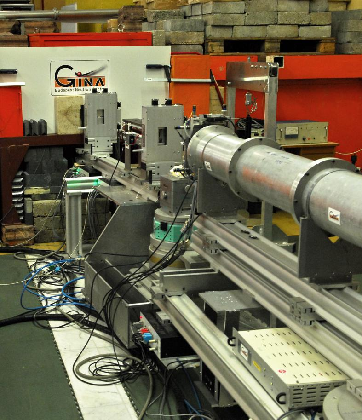Neutron Reflectometer with Polarization Option (GINA)
Budapest Neutron Centre

Neutron reflectometry investigates the elemental/isotopic depth profile and the lateral structure of thin films and nanostructures. The GINA neutron reflectometer is a constant-energy angle-dispersive, vertical-sample instrument. Reflectivity ranges of five orders of magnitude have been measured in magnetic and non-magnetic sample environments.
The 5-element focusing graphite monochromator (MONO in Figure 1) provides neutrons with wavelengths within the range of 3.2-5.7 Å and ∆λ/λ~2%. Without further restructuring, the present stable operation is ensured at a wavelength of 4.67 Å. Unpolarized and polarized beam options are available and can be combined with different sample environment options. The unpolarized beam is provided using a cryo-cooled Be-filter (BF). Higher harmonics intensity is efficiently filtered by a Be block. The transmission of the Be filter is 41% and 87% for λ=4.67 Å, without and with liquid nitrogen cooling, respectively. The polarized neutron beam is produced by using a magnetized supermirror (P1) and an adiabatic radio-frequency (RF) spin flipper (SF1). The beam scattered by the sample may undergo spin analysis by an identical setup of a spin flipper and a single magnetic supermirror spin analyzer (P2, polarized specular beam option), and finally it is detected by a two-dimensional position sensitive detector (DET). The incident intensity is monitored by a beam intensity monitor (IM, efficiency ~0.1% at λ= 4.67 Å).
The central sample tower ST supports the various sample environment components (permanent-magnet sample stage for large samples, electromagnet, cryostat, water cooled Helmholtz coils, thermostated solid/liquid cell, etc.). The incident angle on the sample surface is set by the Θ-goniometer of the ST. The detector arm of the reflectometer-supports the slits S3, and S4 with optional flight tube (unpolarized beam option) or S3, spin flipper SF2, the spin analyzer P2 (polarized beam option) and DET (both options) along with its electronics and dedicated control PC, which is mounted underneath the detector arm. The flight tube may be used to minimize the neutron scattering by air. The detector arm is moved by a wheel running on the marble surface while the corresponding air pads are activated to levitate the arm.
Fine definition of the beam is maintained by the four slits. The blades are operated with a precision of 0.05 mm. With its optical elements the setup exhibits a relative Q-resolution of 10% to 2% for the available Q-range of 0.005 to ~0.25 Å-1. The MONO comprises five highly oriented pyrolytic graphite crystals on small motorized 2-circle cradles for horizontal alignment and vertical focusing. The latter doubles the intensity reflected by a 20×20 mm2 sample at 0.7º incident angle as compared to the non-focused case.
Polarized neutrons are produced either by a single Fe-Co/Si magnetic SM in transmission or by a locally invented 4-bounce SM polarizer in reflection geometry (Rev. Sci. Instrum. 89, 056105 (2018)). Spin analysis of the specularly reflected beam is performed by devices (P2) of identical construction. The spin flippers are of adiabatic RF type [S. V. Grigoriev, A. I. Okorokov, and V. V. Runov, Nucl. Instrum. Methods Phys. Res. A 384, 451 (1997)]. The flipper coil is placed in a longitudinal gradient field of 20-40 mT/m, with a center field of 5.6 mT. The flipper coil is part of a resonant circuit, with typical values of effective RF current and bandwidth of 4 A and 4.5 kHz at the resonance frequency of 166 kHz.
The neutron detetector DET is a delay line type multi-wire proportional chamber (with active area of 200×200 mm2 and spatial resolution of 1.8 mm (FWHM)) encased in boron-containing shielding for background suppression. The detector is filled with a gas mixture of 3He and CF4. A DASY TDC module (made by ESRF, Grenoble) is installed in a slot of the PC dedicated exclusively to the detector data-acquisition.
Contact: László Bottyán, Dániel Merkel
Technical specifications
| Wavelength: | 0.39 ÷ 0.51 nm in five steps |
| Present wavelength: | 0.46 nm |
| Max. scattering angle: | >Θ=35° |
| Angular resolution (ΔΘ): | 0.003º |
| Wavelength spread: | ~1% |
| Background level: | 0.01 cps·cm-2 |
| Detector: | 2D PSD, 200×200 mm2 |
| Detector spatial resolution: | 1.8×1.8 mm2 |
| Neutron flux at the monochromator position: | 4.2×105 n x cm-2 x s-1 |
| Background reflectivity: | <7×10-5 |
| Polarization efficiency of spin polarised/analyzer: | 0.89/0.996 |
Sample environment
GINA is dedicated to magnetic heterostructures, for studies requiring different environmental parameters, such as low temperature and occasionally high external magnetic fields. For room-temperature reflectivity measurements, the sample is held in position by vacuum. Low temperature measurements can be performed in a closed-cycle cryostat (20 to 300 K range) which can be mounted on the sample tower ST with or without the electromagnet and with the sample space evacuated. An air-cooled electromagnet generates magnetic fields up to 0.55 T with pole distance of 40 mm which can accommodate the 1.5” diameter cryostat housing. The optional water-cooled Helmholtz pair provides fields up to approx. 35 mT. A vertical-sample liquid cell with temperature controlled (± 0.1K) liquid space is available to investigate Si-adhered soft matter films and membranes.
Detailed information can be found on the instrument’s webpage.
-
20.02.2025
X-ray computed tomography (CT) TomoLab
-
23.01.2025
THz beamline TeraFERMI



